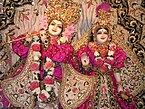Murti
Murti (idols, images) of different deities
|
|||||
A Murti (Sanskrit: मूर्ति, IAST: Mūrti) literally means any form, embodiment or solid object, and typically refers to an image, statue or idol of a deity or person in Indian culture. By the Prana Pratishtha ceremony, the idol becomes identical with the deity.Murtis are also found in some nontheistic Jainism traditions, where they serve as symbols of revered persons inside Jain temples, and are worshipped in Murtipujaka rituals.
A Murti is typically made by carving stone, wood working, metal casting or through pottery. Medieval era texts describing their proper proportions, positions and gestures include the Puranas, Agamas and Samhitas. The expressions in a Murti vary in diverse Hindu traditions, ranging from Ugra symbolism to express destruction, fear and violence (Durga, Kali), as well as Saumya symbolism to express joy, knowledge and harmony (Saraswati, Lakshmi). Saumya images are most common in Hindu temples. Other Murti forms found in Hinduism include the Linga.
A Murti is an embodiment of the divine, the Ultimate Reality or Brahman to some Hindus. In religious context, they are found in Hindu temples or homes, where they may be treated as a beloved guest and serve as a participant of Puja rituals in Hinduism. In other occasions, it serves as the center of attention in annual festive processions and these are called Utsava Murti.
Murti is sometimes referred to as murthi, or vigraha or pratima.
Murti literally means any solid body or form with definite shape or limits produced from material elements. It contrasts with mind, thought and the immaterial in ancient Indian literature. The term also refers to any embodiment, manifestation, incarnation, personification, appearance, image, idol or statue of a deity.
The earliest mention of the term Murti occurs in primary Upanishads composed in the 1st millennium BCE, particularly in verse 3.2 of Aitareya Upanishad, verse 1.13 of Shvetashvatara Upanishad, verse 6.14 of Maitrayaniya Upanishad and verse 1.5 of Prashna Upanishad. For example, the Maitrayaniya Upanishad uses the term to mean a "form, manifestation of time". The section sets out to prove Time exists, acknowledges the difficulty in proving Time exists by Pramana (epistemology in Indian philosophy), then inserts a theory of inductive inference for epistemological proof as follows,
...
Wikipedia




